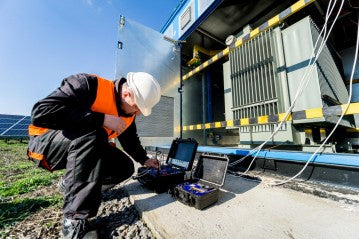
In the world of solar energy, one crucial component often overlooked by potential customers is the inverter. While the solar panels capture sunlight and convert it into DC electricity, it's the inverter's job to transform that DC power into the usable AC electricity we rely on. Traditional central inverters have long been the go-to choice, but today we'll explore an alternative: solar micro inverters. In this article, we'll delve into the world of solar microinverters, discuss their benefits, and help you determine when it's best to integrate them into your solar energy system.
Understanding Solar Inverters
Before we dive into microinverters, let's quickly touch upon traditional central inverters. These inverters are typically located in a centralized location and handle the DC to AC conversion for the entire solar array. While central inverters have been the industry standard for years, recent advancements have given rise to a new player: solar microinverters.
So, what exactly are solar microinverters? In simple terms, they are small, individual inverters attached to each solar panel. Instead of relying on a centralized inverter, each panel has its own microinverter, optimizing the performance of each unit independently. This approach comes with several advantages.
Advantages of Solar Microinverters
1. Individual Panel Optimization: With microinverters, each solar panel operates at its maximum potential, unaffected by shading or performance issues of other panels. This ensures you get the highest energy output from each panel, maximizing your overall system efficiency.
2. Enhanced System Performance: Microinverters minimize power losses caused by shading, soiling, or panel mismatches. Unlike traditional inverters, where a single underperforming panel can drag down the entire system, microinverters isolate any issues, ensuring other panels continue producing at peak capacity.
3. Simplified Design and Installation: Microinverters eliminate the need for complex string design calculations. With central inverters, panels need to be arranged in specific configurations, which can be challenging if your roof space is limited or irregular. Microinverters offer greater flexibility, allowing panels to be installed in various orientations and tilts without compromising efficiency.
4. Increased Flexibility and Scalability: Microinverters make it easier to expand your solar system in the future. You can simply add new panels with their respective microinverters, without worrying about compatibility issues or system-wide modifications.
Evaluating Situations for Microinverters
Now that we understand the benefits of microinverters, let's explore when they are most suitable.
1. Residential Installations
- Rooftop Solar Systems: If you have limited roof space or irregular roof structures, microinverters are ideal since they allow for flexible panel configurations.
- Partial Shading Challenges: Microinverters mitigate the impact of shading on energy production, making them perfect for homes with trees, neighboring buildings, or other obstructions.
- Variable Orientations and Tilts: Microinverters accommodate panels facing different directions or tilted at varying angles, maximizing energy production in diverse situations.
- Maximizing Energy Production per Panel: If you aim to squeeze every last drop of power from each solar panel, microinverters are your best bet.
2. Commercial Installations
- Complex Rooftops and Shading Issues: Commercial buildings often have intricate rooftop structures and shading challenges. Microinverters help optimize energy production despite these obstacles.
- Mixed Panel Orientations and Uneven Strings: Microinverters allow for greater flexibility in arranging panels with different orientations or non-uniform string lengths.
- Monitoring and Maintenance Advantages: The ability to monitor individual panel performance simplifies maintenance, making it easier to identify and address any issues promptly.
3. Challenging Environments
- Extremely Hot or Cold Climates: Microinverters perform well in extreme temperatures, ensuring consistent energy production in scorching summers or freezing winters.
- High Humidity or Coastal Areas: Microinverters' sealed designs protect against moisture, making them suitable for areas with high humidity, coastal regions, or salty air.
- Systems Prone to Snow or Debris Shading: Microinverters prevent snow or debris shading from impacting the overall system, allowing for continued operation in challenging weather conditions.
Limitations and Considerations
While solar microinverters offer numerous advantages, it's essential to consider the following factors before making a decision:
1. Cost Implications: Microinverters generally come at a higher upfront cost compared to central inverters. However, the increased energy production and system flexibility can offset this investment over time.
2. System Size and Scalability: Microinverters are ideal for smaller to medium-sized installations. For large-scale systems, central inverters might still be more cost-effective.
3. Monitoring and Maintenance Requirements: Monitoring individual panel performance requires more advanced monitoring systems, which might add to the overall system cost.
4. Technical Compatibility with Existing Installations: If you already have a solar system in place, ensure that the microinverters you choose are compatible with your current panels and wiring.
Conclusion
Solar microinverters offer numerous advantages, enabling optimal energy production, simplified installations, and enhanced system flexibility. Whether you're a homeowner dealing with shading issues or a business owner seeking greater design flexibility, microinverters can significantly improve the performance of your solar energy system. Consider the unique needs of your installation, consult with reputable solar professionals, and make an informed decision to maximize the benefits of solar microinverters in your quest for sustainable energy.


0 Kommentare